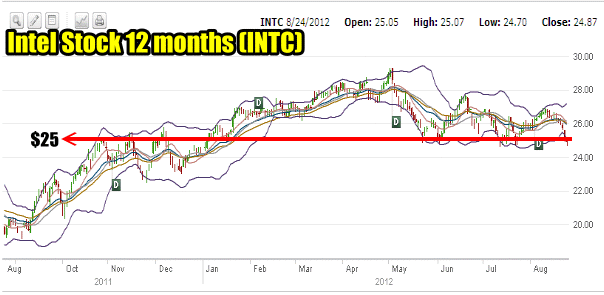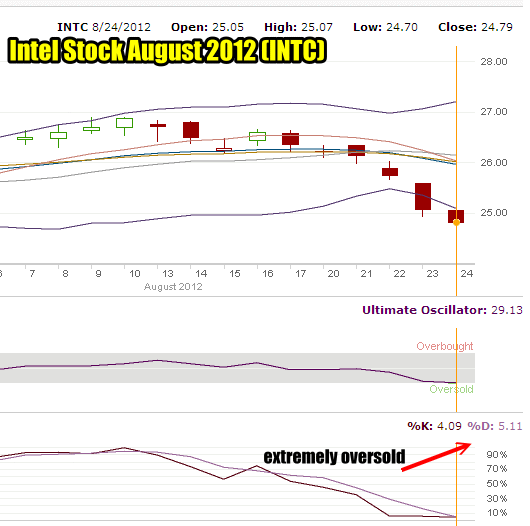I have been busy Put Selling Intel Stock as it has fallen over the past few trading sessions. I started Put Selling on August 21, selling the September $26 puts and Oct $25 naked puts. The following day, August 22 I was Put Selling the September 26 naked puts again and the September $25 and October $24. On August 23 I turned once more to Put Selling Intel Stock and sold the Oct $24. The reason for starting my Put Selling on August 21st was because while Intel stock was in a decline, it is a strong dividend paying large cap stock and there is never a guarantee it is going to fall as far as I think. While in my Intel Stock article on August 21 I indicated the possibility was there for Intel Stock to fall to the $25 level, I could not be guaranteed of this. Therefore I like to do Put Selling against a quality stock like Intel Stock as it falls in case it does not fall as far as I expect.
For investors who NEVER want to own shares in any stock, they must wait until a stock has bottomed, or better yet, commenced an upturn. The Put Selling I have done on Intel Stock over the past few days is because this is a stock I do not mind owning at any of the strikes I have done Put Selling against.
But once the Put Selling has placed my capital at risk, then the question is what is the rolling options strategy that can be applied to help reduce risk of capital loss and early assignment as well as continue to keep the trade profitable. The rolling put strategy I use is simple and easy to implement. Best of all it works on big cap stocks like Intel Stock.
Put Selling Intel Stock Strategy
Therefore the strategy is to engage in Put Selling as the stock falls but do it in small quantities so I can keep taking advantage of the decline in Intel’s stock.Yesterday Intel Stock fell to extremely oversold and I was back put selling. This morning the selling is continuing as you can see in the chart below. For those investors like myself who do not mind owning the stock, an in the money $25 naked put would be excellent premium choice for Put Selling. Put Selling at $25 would probably end up as a continual rolling options for Put Selling investors because $25 has seen a lot of action over the last 12 months.It would have been an excellent choice for repeated put selling.

Put Selling the $25 put strike in Intel Stock would have been an excellent choice for the past 12 months
As I already have some $25 naked puts already I will not be selling more at the $25 strike, but if I had no naked puts at this point I would be put selling the October $25 and the November $24 put strikes.

Intel Stock is now sitting at extremely oversold levels. Put Selling at this point can result in exceptional put premiums.
As I already have quite a few puts I sold into Oct at the $23 strike this morning with the stock down to $24.70 for .38 cents. This brings the total commitment of capital to Put Selling against Intel Stock to $122,585 less the income earned. You can review the Intel Stock Put Selling trades through this Intel Stock link.
Understanding The Put Selling Intel Stock Strategy
Here are the present Put Selling positions:
5 Sept $26 naked puts for .48 cents
5 Sept $26 naked puts for .69 cents
10 Oct $25 naked puts for .50 cents
5 Oct $25 naked puts for .28 cents
10 Oct $24 naked puts for .35
5 Oct $24 naked puts for .52
10 October $23 naked puts for .38
Total income earned = $2103.50
Total Capital In use = $122,585.
Total Put Contracts Sold = 50
If assigned on all put contracts cost basis would be = $24.52 before deducting income earned. This would put my position in Intel Stock below fair value which I believe is around $25.00
The Put Selling strategy now is to wait for a bounce in Intel Stock. If there is a bounce, which is what I am expecting, then it becomes a question of waiting for the bounce to end and Intel stock to fall back again. Then it is a simple case of buying to close the in the money naked puts and rolling further out in time. The out of the money naked puts can be left to either expire or bought to close for pennies.
Put Selling Scenarios
There are two other Put Selling steps in the rolling options strategy for my Intel Stock naked puts.
A) If Intel Stock falls below $26 but above $25 only roll the $26 further out and reduce the number of put contracts in the roll out. In other words, I am holding 10 Sept $26 naked calls. In the roll out I would reduce the number of naked puts by 1 or 2 put contracts to reduce the amount of capital at $26. This then frees up my capital for use at lower strikes. I would therefore reduce to 8 the number at $26 and sell 2 additional naked puts at possibly $23.
So A would look like this: Buy To Close 10 Sept $26 naked puts. Sell To Open 8 Nov $26 naked puts. Sell To Open 2 Nov $23 naked puts.
When Put Selling into November it would depend on the premiums earned. For example, let us say that by September 20 Intel Stock is trading at $25.10. My Intel Stock $26 naked puts should be trading for around $1.00. I know that to buy to close the Sept $26 naked puts will cost me 10 put contracts X $1.00 = $1000.00. I then look out to November. I want to sell just 8 naked puts. I divide 8 put contracts through $1000 = $1.25. I need at least $1.35 to make it worthwhile to do the roll out and reduce the number being sold. If November does not provide it, then I would look at January which could very well afford me the opportunity to sell just 7 put contracts and reduce by 3 the number of put contracts at $26.
I then take the freed up capital and sell naked puts out of the money, probably at the $23 strike.
B) If Intel Stock falls below $25 but above $24. I then buy to close the $26 and $25 naked puts and roll them out in time. The $26 naked puts should be rolled down a strike. The $25 naked puts can be rolled out in time but stay at $25 and reduce the number of contracts being sold.
In scenario B, with Intel Stock below $25.00, it is better to roll down a strike. This will probably mean I will need to roll all 10 put contracts from Sept $26 to Nov $25. For example, if Intel Stock is at $24.70 at Sept 20, the cost to buy to close my 10 naked put Sep $26 put contracts should be around $1.40. To close 10 will cost me $1400.00. I would then roll down to $25.00. As long as November is at least $1.45 I would then roll down into November. I always try to make sure when I roll down it is for a net credit.
The $25 strike though is not worth rolling down, so I would normally roll it out and follow scenario A, reduce the number of naked puts being sold on the roll out.
Both Put Selling Scenarios
Both Put Selling scenarios are working my positions lower in capital requirements and I am continuing to sell more puts at lower strikes. Whether or not I will need to engage in rolling options is difficult to predict at this point in the pullback, but the importance of strategy and having a plan when it comes to investing is paramount to success. By having a plan ready in advance of needing it I am well prepared for any eventuality and can implement my put selling strategy as September options expire.
Warren Buffett Sells His Intel Stock Holdings
A lot is being made of Warren Buffett selling his Intel Stock. I believe that Buffett is an investor like all of us and perhaps has other opportunities for his capital or saw that Intel Stock had pushed up into the $28 valuation which in my opinion was over valued. I will not be at all surprised if Intel Stock falls back to below $21 in the upcoming 12 months, to find out that Buffett loaded up again on Intel Stock. Like all investors there comes a time when a profit should be taken.
But my investment strategy is Put Selling and trading options. Therefore Buffett’s move to dump his Intel Stock shares might increase volatility, even if only for a short while. This means I will benefit through higher option premiums. Aside from this, I see no reason for my being concerned about Buffett’s investment decision. He owns stock, I do options. I like Intel Stock and while above $27 I feel it is over valued, at $25 I think it is fairly valued and that is why I engage in Put Selling at levels I consider fair value in any stock including Intel Stock.

